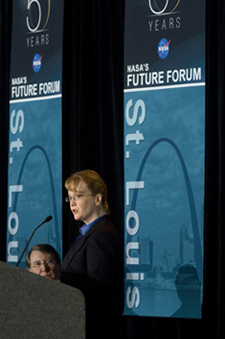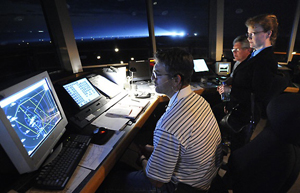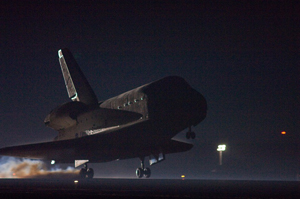St. Louis Future Forum
There were several issues to deal with this week. Earlier this week, there were some issues with the Mars program. Today, Friday, March 28, was the first day back in the office from my road trip, so back-to-back meetings including one on workforce transition from Shuttle to Constellation (more on that next week). I will highlight some of the external events of the week, because that’s the extent of what I feel I can discuss.
 On Tuesday, March 25, I spoke at the St. Louis Future Forum which was held in the beautiful St. Louis Science Center. This was the third Future Forum held as part of NASA’s 50th year long anniversary celebration. As I have said in previous blogs, the intent of the Future Forum is to reach out to communities that may not be as knowledgeable about the space program as those of us that live it every day.
On Tuesday, March 25, I spoke at the St. Louis Future Forum which was held in the beautiful St. Louis Science Center. This was the third Future Forum held as part of NASA’s 50th year long anniversary celebration. As I have said in previous blogs, the intent of the Future Forum is to reach out to communities that may not be as knowledgeable about the space program as those of us that live it every day.
If you read my speeches, you know I spend a great deal of time talking about the space economy and the tangible benefits we all receive from the space program. At the Future Forums, the makeup of the audience ranges from undergraduates to business owners, as well as the general public. It is a varied group and yet they are truly interested in learning more about what we do on a daily basis and are very surprised to learn how NASA impacts their lives.
Carl Walz and I did an informal press conference with Doug King, the Director of the St. Louis Science Center. Camera crews from the local stations, Fox TV2 and KSDK (NBC) were on hand to tape us. After that, Jon Grayson with radio station KMOX. And before we hit the airport, we sat with the editorial board of the St. Louis Post-Dispatch. Namely the reporters and editors asked similar questions such as how are we able to accomplish so much within such a constrained budget; what is planned for the next generation of human spaceflight, what are some of the challenges, and why did you come to St. Louis?
The timing of the St. Louis Future Forum was perfect. Numerous individuals came up to me to talk about their hometown hero, STS-123 Mission Specialist Robert Behnken. When I told them I was on my way to the Kennedy Space Center to watch the landing of Endeavour with him on board, they were thrilled. Robert is a native son of the St. Louis area and they are extremely proud of him.
STS-123 Landing
This was my first opportunity to view a landing as NASA’s Deputy Administrator. The STS-123 crew accomplished so much in the time they were in orbit and this mission is the longest to date. What an incredible accomplishment. STS-123 was another building mission to the International Space Station (ISS) where the crew delivered and attached the Kibo Module and Dextre.
 Initially, I sat with Mike Griffin on-console in the Launch Control Center (LCC) and listened to the communications between the LCC, Mission Control Center, the Shuttle Training Aircraft and the crew of Endeavour as discussions were held on the weather. The crew was told to do a wave off of the first landing opportunity due to cloud cover in the area. After de-orbit burn, we went to the landing strip to wait.
Initially, I sat with Mike Griffin on-console in the Launch Control Center (LCC) and listened to the communications between the LCC, Mission Control Center, the Shuttle Training Aircraft and the crew of Endeavour as discussions were held on the weather. The crew was told to do a wave off of the first landing opportunity due to cloud cover in the area. After de-orbit burn, we went to the landing strip to wait.
 About two minutes before we were able to see the orbiter come into view, there were two sonic booms in quick succession and then Endeavour appeared to glide through the brightness of the xenon lights at the head of the runway. Then once again, she was back on terra firma. This was the 16th night landing at KSC, the 22nd night landing in the Space Shuttle program, and the 68th landing at KSC. Once again, it was an amazing achievement in our human spaceflight program. On March 11, we wished the Endeavour and her crew Godspeed and on March 26, we welcomed her home.
About two minutes before we were able to see the orbiter come into view, there were two sonic booms in quick succession and then Endeavour appeared to glide through the brightness of the xenon lights at the head of the runway. Then once again, she was back on terra firma. This was the 16th night landing at KSC, the 22nd night landing in the Space Shuttle program, and the 68th landing at KSC. Once again, it was an amazing achievement in our human spaceflight program. On March 11, we wished the Endeavour and her crew Godspeed and on March 26, we welcomed her home.

 I participated in a number of events surrounding the launch of the Space Shuttle Endeavor (STS-123), the 25th Space Shuttle assembly mission to the International Space Station (ISS). In a spectacular night launch that lit up the coast of Florida surrounding Kennedy Space Center (KSC), Space Shuttle Endeavor lifted off very early on Tuesday morning. I gave the
I participated in a number of events surrounding the launch of the Space Shuttle Endeavor (STS-123), the 25th Space Shuttle assembly mission to the International Space Station (ISS). In a spectacular night launch that lit up the coast of Florida surrounding Kennedy Space Center (KSC), Space Shuttle Endeavor lifted off very early on Tuesday morning. I gave the  I asked Jim to share some of his thoughts after the tour on Monday. He was impressed by the quality of care provided to these men and women and we actually heard this sentiment echoed by numerous patients. He also noted that the members of the hospital staff care deeply about their patients and are also passionate about providing the appropriate medical and emotional support needed for these brave young men and women. Jim also indicated that although the men and women we visited were physically wounded, there was not a single complaint. Rather, it was a focus on rehabilitation, recovery, and continued service to country.
I asked Jim to share some of his thoughts after the tour on Monday. He was impressed by the quality of care provided to these men and women and we actually heard this sentiment echoed by numerous patients. He also noted that the members of the hospital staff care deeply about their patients and are also passionate about providing the appropriate medical and emotional support needed for these brave young men and women. Jim also indicated that although the men and women we visited were physically wounded, there was not a single complaint. Rather, it was a focus on rehabilitation, recovery, and continued service to country.  For the patients we visited, the highlight was getting to meet Tim Kopra. He had a wonderful touch with everyone he met and took pictures with most of the patients and staff. Everyone loves to meet an astronaut and I am very thankful that he could be there with us. Due to the pre-dawn liftoff of STS-123, these soldiers were unable to attend, but I look forward to seeing some of them in May for STS-124.
For the patients we visited, the highlight was getting to meet Tim Kopra. He had a wonderful touch with everyone he met and took pictures with most of the patients and staff. Everyone loves to meet an astronaut and I am very thankful that he could be there with us. Due to the pre-dawn liftoff of STS-123, these soldiers were unable to attend, but I look forward to seeing some of them in May for STS-124. 



